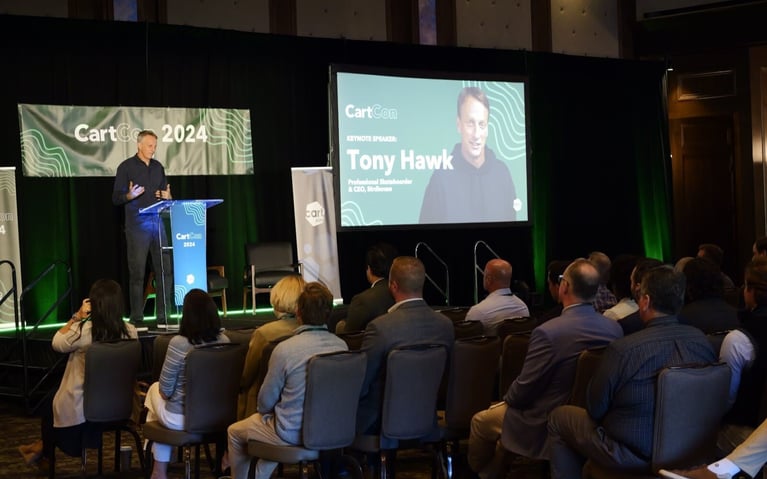I spent a few days last week representing Cart.com at NRF Nexus, which is the National Retail Federation’s new sister conference focused on digital and technology topics. In attendance were eight vendors (one of which was Cart.com) alongside 200+ managers, VPs and CXOs from the show’s target industry backgrounds. The conference was intimate, including many opportunities to deep dive with teams about the challenges they’re facing in today’s uncertain ecommerce environment.
In case you missed it, here are my top three takeaways from NRF Nexus:
1. Tech simplicity vs. flexibility: Chasing shiny objects is so 2020
Multiple sessions led us to explore whether companies could have the best of both worlds: a tech stack that’s easy to use, but still adaptable for evolving brand needs. For example, the founder of a Fortune 1000 strategy consulting group for retailers presented different approaches used by two well-known global DTC brands (who shall remain nameless):
Company X developed a headless platform with a strategic partner to manage its portfolio of products and brands starting three years ago. Development costs so far are about $2.5M and cover 40% of online sales.
Company Y began DTC sales for one of its brands on Shopify Advanced after purchasing a subscription online with a credit card. Since then, the company has adopted this approach across its brand portfolio, with 100% of DTC sales across 10 brands coming from Shopify (to this day, they still don’t have a Shopify rep). Company Y has since reduced its subscription to the standard Shopify pricing tier based on the valuable features offered by the platform and pays less than $50k per year in development fees.
The takeaway: CEOs no longer equate infinite customization with success. And while their tech leaders chase flexible platforms that might solve any future business problem, business leaders would prefer cost-effective and sustainable models that cover the most important business challenges. To CEOs, it’s becoming more critical for the business to self-serve quick iterations on common use cases, instead of having long development cycles to potentially squeeze percentage points from any one metric.
2. Brands are testing social commerce, but don’t yet believe in the Metaverse
Live shopping looks much different in the U.S. compared to Asia, where just 10 influencer anchors cover more than 70% of live shopping sales in China. Meanwhile stateside, live shopping looks more like direct marketing: even Amazon Live shopping is still too new for there to be a codified opinion on sales impact, and influencer shopping hasn’t worked yet in tests. American brands do see near-term returns on some forms of social commerce, but still believe the Metaverse to be too niche.
For example, I caught up with one digital VP who said his brand had great success assigning individual shoppers to sales reps who are then responsible for doing live shows based on commission. The experiment is still new, but early feedback is positive with increases of 40-60% in AOV. On the other hand, in a closed Digital Council session, another attendee discussed the Metaverse and how brands should be exploring it as a first-mover advantage. He was met with heavy resistance by execs from major brands in attendance, who believed the Metaverse population is a gamer demographic and should be treated as such in their targeting.
The takeaway: Social commerce will grow in the U.S. with early returns, but it won’t be a predominant sales model anytime soon. Most execs believe the Metaverse will continue to be a niche audience in the near term and will face significant challenges in being widely adopted, while unique mobile and gamified experiences will be the low-hanging fruit for brands today.
3. Artificial intelligence is only a tool in delivering better outcomes
Artificial intelligence (AI) was, as always, a hot topic in multiple sessions, with anecdotes about brands spending too much money on technology—but not focusing on the outcomes it provides (e.g. “just another type of hammer”). When it comes to AI, most use cases being tackled are either customer-facing (think product recommendations, catalog assortment, fitment, etc.) or relate to inventory management (due to P&L impact).
For example, in a Think Tank session with CTOs from some of the world’s largest brands, most speakers mentioned previously expanding and now reducing their data science departments due to a lack of return and focus on outcomes. These leaders are still looking for use cases with AI as an enabler, but are now approaching vendors and providers who rely on “AI” as the lynchpin in their messaging with skepticism.
The takeaways: AI is in the “trough of disillusionment” of Gartner’s Hype Cycle Model and brands are now more educated that use cases must be tied to business metrics, like a forecasted percent change in revenue or operations cost.
To learn more about how Cart.com can help your brand grow with low-cost, flexible technology, get in touch.





